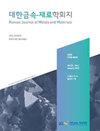3D花状二氧化钒优化缓解锂硫电池多硫穿梭效应
IF 1.1
4区 材料科学
Q4 MATERIALS SCIENCE, MULTIDISCIPLINARY
引用次数: 0
摘要
随着便携式设备和储能系统(ESS)的快速发展,对高能量密度、高容量的二次电池的需求越来越大。在各种候选电池中,锂硫(Li-S)电池由于其高理论容量(1675 mAh g<sup>-1</sup>)和能量密度(2500 Wh kg<sup>-1</sup>)而被考虑用于下一代能源设备。然而,锂硫电池的商业化面临挑战,因为硫的低导电性和穿梭效应,在充放电过程中,多硫化锂中间体溶解在电解质中。为了解决这些问题,我们报道了用简单的水热法制备二氧化钒(VO<sub>2</sub>)复合材料,并优化了VO<sub>2</sub>构建有效的多壁碳纳米管(MWCNT)和三维花形碳纳米管<sub>2</sub>(MWCNT@VO<sub>2</sub>)二元硫宿主的简单熔体扩散法。特别是极性的VO<sub>2</sub>复合材料不仅物理吸附可溶的多硫化锂,而且对多硫化锂具有较高亲和力的强化学键,起到催化剂的作用,增强了电化学可逆性。此外,MWCNT改善了硫的导电性差,并缓冲了循环过程中的体积膨胀。设计的S-MWCNT@VO<sub>2</sub>作为锂多硫化物储层,电极也表现出比裸S-MWCNT电极更好的容量保持和循环性能。本文章由计算机程序翻译,如有差异,请以英文原文为准。
Alleviating the Polysulfide Shuttle Effect by Optimization of 3D Flower-Shaped Vanadium Dioxide for Lithium-Sulfur Batteries
With the rapid development of portable devices and Energy Storage Systems (ESS), secondary batteries with high energy density and high capacity are in great demand. Among various candidates, Lithium-sulfur (Li-S) batteries have been considered for next-generation energy devices given their high theoretical capacity (1675 mAh g-1) and energy density (2500 Wh kg-1). However, the commercialization of Li-S batteries faces challenges due to sulfur’s low electrical conductivity and the shuttle effect, caused by the dissolution of lithium polysulfide intermediates in the electrolyte during the charge-discharge process. Herein, to resolve these problems, we report the fabrication of a vanadium dioxide (VO2) composite via a simple hydrothermal method and optimize the structure of VO2 for constructing an effective Multi-Walled Carbon Nano Tube (MWCNT) and 3D flower-shaped VO2 (MWCNT@VO2) binary sulfur host by a simple melt diffusion method. In particular, the polar VO2 composite not only physically absorbs the soluble lithium polysulfides but also has strong chemical bonds with a higher affinity for lithium polysulfides, which act as a catalyst, enhancing electrochemical reversibility. Additionally, MWCNT improves sulfur’s poor electrical conductivity and buffers volume expansion during cycling. The designed S-MWCNT@VO2 electrode also exhibits better capacity retention and cycling performance than a bare S-MWCNT electrode as a lithium polysulfide reservoir.
求助全文
通过发布文献求助,成功后即可免费获取论文全文。
去求助
来源期刊

Korean Journal of Metals and Materials
MATERIALS SCIENCE, MULTIDISCIPLINARY-METALLURGY & METALLURGICAL ENGINEERING
CiteScore
1.80
自引率
58.30%
发文量
100
审稿时长
4-8 weeks
期刊介绍:
The Korean Journal of Metals and Materials is a representative Korean-language journal of the Korean Institute of Metals and Materials (KIM); it publishes domestic and foreign academic papers related to metals and materials, in abroad range of fields from metals and materials to nano-materials, biomaterials, functional materials, energy materials, and new materials, and its official ISO designation is Korean J. Met. Mater.
 求助内容:
求助内容: 应助结果提醒方式:
应助结果提醒方式:


